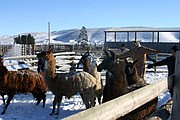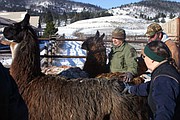End of an ordeal
Volunteers brought a 42-day ordeal to a close last Monday at the now-defunct Montana Large Animal Sanctuary and Rescue in Niarada after moving the last 150 animals from the property. The effort, lead by AniMeals of Missoula, has been called one of the largest animal rescue operations ever carried out after what has come to be known as one of the largest cases of animal neglect in history.
According to Karyn Moltzen, the founder of AniMeals, the situation began on Dec. 7, when the owners of the sanctuary contacted AniMeals to request assistance in feeding the animals. AniMeals delivered 30 tons of hay to the property. Then on Dec. 21, AniMeals was asked to return to the sanctuary to help with the animals after the owners had left.
“We came up and planned to stay a week, but we never left,” Moltzen said.
The proximal issue at the sanctuary was a loss of funding in November, according to volunteer Dick Williams, who is on the board of the Rocky Mountain Llama Association. It was on Dec. 22 that the Humane Society took legal control over all of the animals, Williams said, and AniMeals took physical possession of the sanctuary. The owners then left the premises. They activated several rescue organizations throughout the country to deal with the conditions they found the animals in.
“The problem has been that all of the animals are severely malnourished,” Williams said, “and have a number of other health issues because they haven’t been cared for up at the sanctuary.”
Voluteers who responded to the crisis found the over 1,200 large animals at the sanctuary to be in very poor condition.
“We had horses whose hooves had grown so long they grew back to the top of the foot,” Williams said. “That’s something that doesn’t happen in a month. That’s long-term abuse.”
Williams and Moltzen both said that they found animals on the verge of starvation, and based on accepted weight scales, these animals were found to be severely underweight.
“We’ve had animals that we’ve had to literally pick up and put in trailers because they are not physically capable of getting up and standing on their own,” Williams said. “That’s not something that happens in a month.”
The animals were scattered over 400 acres, and the first thing volunteers did was to round all of the animals up. After that, the next step was to begin feeding the animals and to try and bring their health back up. Still, this didn’t happen overnight.
“Any time you take an animal from the brink of starvation, it takes two weeks for the nutrition to get in them enough to keep them from dying,” Moltzen said. “So for two weeks, they were still dying.”
From there, volunteers worked with other animal advocacy organizations to relocate the animals. Most of the horses were moved to the Bozeman area, where they are recuperating and being brought back to a healthy weight. The camels, bison, cattle and the emus have all been placed in temporary homes in western Montana. Of the approximately 600 llamas in the sanctuary, 100 have been moved to New York State, 80 to Georgia, and some in Indiana, Colorado, Texas, and Washington. All told, about a third of the animals have permanent homes. The rest of them are in intermediate facilities where they are trying to get healthy enough to be adopted elsewhere.
According to Williams, the neglect seen at the sanctuary predates the loss of funding.
“They’ve had no basic care at all,” Williams said.
Moltzen cites not only understaffing, but also apathy for the neglect.
“They didn’t have enough people to take care of the animals and quite frankly, they didn’t care,” Moltzen said.
The ordeal has been taxing on volunteers, many of whom had worked to save the animals since the end of December. Even towards the end, Williams said that it was tough on everyone.
“We had 20 people up there loading llamas on Tuesday and there wasn’t anybody up there who wasn’t crying,” Williams said.
The volunteers are just thrilled to have all of the animals off of the sanctuary and being cared for at places across the nation.
“Moving over 1,200 animals in less than a month has been the most rewarding,” Moltzen said. “We started moving animals on the fourth and today is the 31st. We got every single animal off of this property. I don’t know how we did it.”
“We’re just absolutely amazed that we’ve been able to get these animals off the sanctuary,” Williams said.





